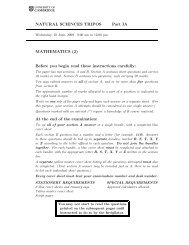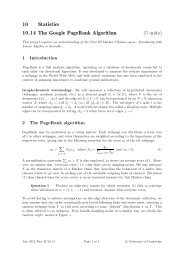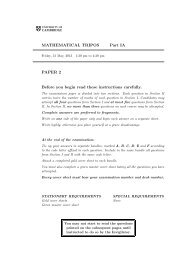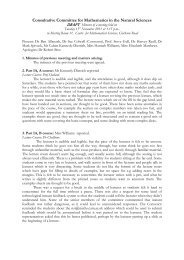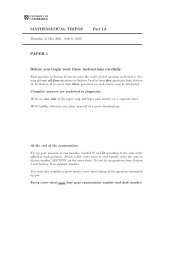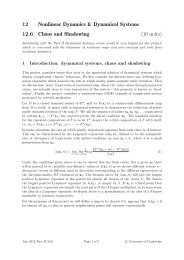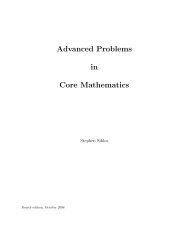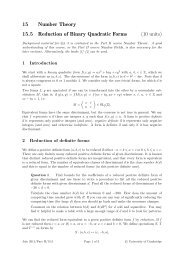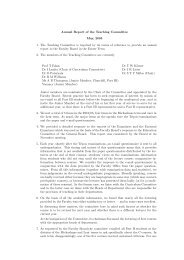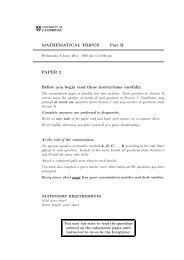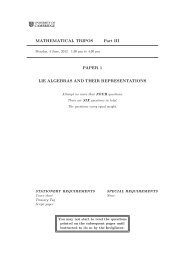MATHEMATICAL TRIPOS Part II PAPER 3 Before you begin read ...
MATHEMATICAL TRIPOS Part II PAPER 3 Before you begin read ...
MATHEMATICAL TRIPOS Part II PAPER 3 Before you begin read ...
- No tags were found...
Create successful ePaper yourself
Turn your PDF publications into a flip-book with our unique Google optimized e-Paper software.
<strong>MATHEMATICAL</strong> <strong>TRIPOS</strong><strong>Part</strong> <strong>II</strong>Thursday, 6 June, 20131:30 pm to 4:30 pm<strong>PAPER</strong> 3<strong>Before</strong> <strong>you</strong> <strong>begin</strong> <strong>read</strong> these instructions carefully.The examination paper is divided into two sections. Each question in Section <strong>II</strong>carries twice the number of marks of each question in Section I. Candidates mayattempt at most six questions from Section I and any number of questions fromSection <strong>II</strong>.Complete answers are preferred to fragments.Write on one side of the paper only and <strong>begin</strong> each answer on a separate sheet.Write legibly; otherwise <strong>you</strong> place <strong>you</strong>rself at a grave disadvantage.At the end of the examination:Tie up <strong>you</strong>r answers in bundles, marked A, B, C, . . ., K according to the code letteraffixed to each question. Include in the same bundle all questions from Sections Iand <strong>II</strong> with the same code letter.Attach a completed gold cover sheet to each bundle.You must also complete a green master cover sheet listing all the questions <strong>you</strong> haveattempted.Every cover sheet must bear <strong>you</strong>r examination number and desk number.STATIONERY REQUIREMENTSGold cover sheetGreen master cover sheetYou may not start to <strong>read</strong> the questionsprinted on the subsequent pages untilinstructed to do so by the Invigilator.
21ISECTION INumber TheoryState the Chinese Remainder Theorem.A composite number n is defined to be a Carmichael number if b n−1 ≡ 1 mod nwhenever (b, n) = 1. Show that a composite n is Carmichael if and only if n is square-freeand (p − 1) divides (n − 1) for all prime factors p of n. [You may assume that, for p anodd prime and α 1 an integer, ( Z/p α Z ) × is a cyclic group.]Show that if n = (6t + 1)(12t + 1)(18t + 1) with all three factors prime, then n isCarmichael.2F Topics in AnalysisState Brouwer’s fixed point theorem. Let f : R 2 → R 2 be a continuous functionwith the property that |f(x) − x| 1 for all x. Show that f is surjective.3G Geometry and GroupsLet Λ be a rank 2 lattice in the Euclidean plane. Show that the group G of allEuclidean isometries of the plane that map Λ onto itself is a discrete group. List thepossible sizes of the point groups for G and give examples to show that point groups ofthese sizes do arise.[You may quote any standard results without proof.]4H Coding and CryptographyDescribe briefly the Rabin cipher with modulus N, explaining how it can bedeciphered by the intended recipient and why it is difficult for an eavesdropper to decipherit.The Cabinet decides to communicate using Rabin ciphers to maintain confidentiality.The Cabinet Secretary encrypts a message, represented as a positive integer m, usingthe Rabin cipher with modulus N (with 0 < m < N) and publishes both the encryptedmessage and the modulus. The Defence Secretary deciphers this message to <strong>read</strong> it butthen foolishly encrypts it again using a Rabin cipher with a different modulus N ′ (withm < N ′ ) and publishes the newly encrypted message and N ′ . Mr Rime (the Leader of theOpposition) knows this has happened. Explain how Rime can work out what the originalmessage was using the two different encrypted versions.Can Rime decipher other messages sent out by the Cabinet using the originalmodulus N?<strong>Part</strong> <strong>II</strong>, Paper 3
510D CosmologyThe number densities of protons of mass m p or neutrons of mass m n in kineticequilibrium at temperature T , in the absence of any chemical potentials, are each givenby (with i = n or p)n i = g i(mi k B T2π 2 ) 3/2exp [ −m i c 2 /k B T ] ,where k B is Boltzmann’s constant and g i is the spin degeneracy.Use this to show, to a very good approximation, that the ratio of the number ofneutrons to protons at a temperature T ≃ 1MeV/k B is given byn nn p= exp [ −(m n − m p )c 2 /k B T ] ,where (m n − m p )c 2 = 1.3MeV . Explain any approximations <strong>you</strong> have used.The reaction rate for weak interactions between protons and neutrons at energies5MeV k B T 0.8MeV is given by Γ = (k B T/1MeV ) 5 s −1 and the expansion rate of theuniverse at these energies is given by H = (k B T/1MeV ) 2 s −1 . Give an example of a weakinteraction that can maintain equilibrium abundances of protons and neutrons at theseenergies. Show how the final abundance of neutrons relative to protons can be calculatedand use it to estimate the mass fraction of the universe in helium-4 after nucleosynthesis.What would have happened to the helium abundance if the proton and neutronmasses had been exactly equal?<strong>Part</strong> <strong>II</strong>, Paper 3[TURN OVER
6SECTION <strong>II</strong>11I Number TheoryDefine equivalence of binary quadratic forms and show that equivalent forms havethe same discriminant.Show that an integer n is properly represented by a binary quadratic form ofdiscriminant d if and only if x 2 ≡ d mod 4n is soluble in integers. Which primes arerepresented by a form of discriminant −20?What does it mean for a positive definite form to be reduced? Find all reducedforms of discriminant −20. For each member of <strong>you</strong>r list find the primes less than 100represented by the form.12F Topics in AnalysisSuppose that x 0 , x 1 , . . . , x n ∈ [−1, 1] are distinct points. Let f be an infinitelydifferentiable real-valued function on an open interval containing [−1, 1]. Let p be theunique polynomial of degree at most n such that f(x r ) = p(x r ) for r = 0, 1, . . . , n. Showthat for each x ∈ [−1, 1] there is some ξ ∈ (−1, 1) such thatNow take x r = cos 2r+12n+2π. Show thatf(x) − p(x) = f (n+1) (ξ)(n + 1)! (x − x 0) . . . (x − x n ) .|f(x) − p(x)| 12 n sup |f (n+1) (ξ)|(n + 1)! ξ∈[−1,1]for all x ∈ [−1, 1]. Deduce that there is a polynomial p of degree at most n such that∣ 1 ∣∣∣∣3 + x − p(x) 14 n+1for all x ∈ [−1, 1].<strong>Part</strong> <strong>II</strong>, Paper 3
13A Mathematical BiologyAn activator-inhibitor system is described by the equationswhere a, b, d > 0.∂u∂t∂v∂t7= ∂2 u∂x 2 + u − uv + au2 ,= d ∂2 v∂x 2 + u2 − buv ,Find and sketch the range of a, b for which the spatially homogeneous system hasa stable stationary solution with u > 0 and v > 0.Considering spatial perturbations of the form cos(kx) about the solution foundabove, find conditions for the system to be unstable. Sketch this region in the (d, b) planefor fixed a ∈ (0, 1).Find k c , the critical wavenumber at the onset of the instability, in terms of a and b.14C Dynamical SystemsLet f : I → I be a continuous map of an interval I ⊂ R. Explain what is meantby the statements (a) f has a horseshoe and (b) f is chaotic according to Glendinning’sdefinition of chaos.Assume that f has a 3-cycle {x 0 , x 1 , x 2 } with x 1 = f(x 0 ), x 2 = f(x 1 ), x 0 = f(x 2 ),x 0 < x 1 < x 2 . Prove that f 2 has a horseshoe. [You may assume the Intermediate ValueTheorem.]Represent the effect of f on the intervals I a = [x 0 , x 1 ] and I b = [x 1 , x 2 ] by means ofa directed graph. Explain how the existence of the 3-cycle corresponds to this graph.The map g : I → I has a 4-cycle {x 0 , x 1 , x 2 , x 3 } with x 1 = g(x 0 ), x 2 = g(x 1 ),x 3 = g(x 2 ) and x 0 = g(x 3 ). If x 0 < x 3 < x 2 < x 1 is g necessarily chaotic? [You may usea suitable directed graph as part of <strong>you</strong>r argument.]How does <strong>you</strong>r answer change if x 0 < x 2 < x 1 < x 3 ?<strong>Part</strong> <strong>II</strong>, Paper 3[TURN OVER
815D CosmologyThe contents of a spatially homogeneous and isotropic universe are modelled asa finite mass M of pressureless material whose radius r(t) evolves from some constantreference radius r 0 in proportion to the time-dependent scale factor a(t), withr(t) = a(t)r 0 .(i) Show that this motion leads to expansion governed by Hubble’s Law. If thisuniverse is expanding, explain why there will be a shift in the frequency of radiationbetween its emission from a distant object and subsequent reception by an observer. Definethe redshift z of the observed object in terms of the values of the scale factor a(t) at thetimes of emission and reception.(ii) The expanding universal mass M is given a small rotational perturbation, withangular velocity ω, and its angular momentum is subsequently conserved. If deviationsfrom spherical expansion can be neglected, show that its linear rotational velocity will fallas V ∝ a −n , where <strong>you</strong> should determine the value of n. Show that this perturbationwill become increasingly insignificant compared to the expansion velocity as the universeexpands if a ∝ t 2/3 .(iii) A distant cloud of intermingled hydrogen (H) atoms and carbon monoxide (CO)molecules has its redshift determined simultaneously in two ways: by detecting 21 cmradiation from atomic hydrogen and by detecting radiation from rotational transitions inCO molecules. The ratio of the 21 cm atomic transition frequency to the CO rotationaltransition frequency is proportional to α 2 , where α is the fine structure constant. It issuggested that there may be a small difference in the value of the constant α between thetimes of emission and reception of the radiation from the cloud.Show that the difference in the redshift values for the cloud, ∆z = z CO − z 21 ,determined separately by observations of the H and CO transitions, is related to δα =α r − α e , the difference in α values at the times of reception and emission, by( ) δα∆z = 2 (1 + z CO ) .α r(iv) The universe today contains 30% of its total density in the form of pressurelessmatter and 70% in the form of a dark energy with constant redshift-independent density.If these are the only two significant constituents of the universe, show that their densitieswere equal when the scale factor of the universe was approximately equal to 75% of itspresent value.<strong>Part</strong> <strong>II</strong>, Paper 3
916G Logic and Set TheoryExplain carefully what is meant by syntactic entailment and semantic entailment inthe propositional calculus. State the Completeness Theorem for the propositional calculus,and deduce the Compactness Theorem.Suppose P , Q and R are pairwise disjoint sets of primitive propositions, and letφ ∈ L(P ∪ Q) and ψ ∈ L(Q∪R) be propositional formulae such that (φ ⇒ ψ) is a theoremof the propositional calculus. Consider the setX = {χ ∈ L(Q) | φ ⊢ χ} .Show that X ∪ {¬ψ} is inconsistent, and deduce that there exists χ ∈ L(Q) such thatboth (φ ⇒ χ) and (χ ⇒ ψ) are theorems. [Hint: assuming X ∪ {¬ψ} is consistent, takea suitable valuation v of Q ∪ R and show that{φ} ∪ {q ∈ Q | v(q) = 1} ∪ {¬q | q ∈ Q, v(q) = 0}is inconsistent. The Deduction Theorem may be assumed without proof.]17F Graph TheoryLet G be a graph of order n and average degree d. Let A be the adjacency matrixof G and let x n + c 1 x n−1 + c 2 x n−2 + · · · + c n be its characteristic polynomial. Show thatc 1 = 0 and c 2 = −nd/2. Show also that −c 3 is twice the number of triangles in G.The eigenvalues of A are λ 1 λ 2 · · · λ n . Prove that λ 1 d.Evaluate λ 1 +· · ·+λ n . Show that λ 2 1 +· · ·+λ2 n = nd and infer that λ 1 √ d(n − 1).Does there exist, for each n, a graph G with d > 0 for which λ 2 = · · · = λ n ?18I Galois TheoryLet p be a prime number and F a field of characteristic p. Let Fr p : F → F be theFrobenius map defined by Fr p (x) = x p for all x ∈ F .(i) Prove that Fr p is a field automorphism when F is a finite field.(ii) Is the same true for an arbitrary algebraic extension F of F p ?answer.Justify <strong>you</strong>r(iii) Let F = F p (X 1 , . . . , X n ) be the rational function field in n variables wheren 1 over F p . Determine the image of Fr p : F → F , and show that Fr p makes F into anextension of degree p n over a subfield isomorphic to F . Is it a separable extension?<strong>Part</strong> <strong>II</strong>, Paper 3[TURN OVER
1019G Representation TheorySuppose that (ρ 1 , V 1 ) and (ρ 2 , V 2 ) are complex representations of the finite groupsG 1 and G 2 respectively. Use ρ 1 and ρ 2 to construct a representation ρ 1 ⊗ ρ 2 of G 1 × G 2on V 1 ⊗ V 2 and show that its character satisfiesfor each g 1 ∈ G 1 , g 2 ∈ G 2 .χ ρ1 ⊗ρ 2(g 1 , g 2 ) = χ ρ1 (g 1 )χ ρ2 (g 2 )Prove that if ρ 1 and ρ 2 are irreducible then ρ 1 ⊗ ρ 2 is irreducible as a representationof G 1 × G 2 . Moreover, show that every irreducible complex representation of G 1 × G 2arises in this way.Is it true that every complex representation of G 1 × G 2 is of the form ρ 1 ⊗ ρ 2 withρ i a complex representation of G i for i = 1, 2? Justify <strong>you</strong>r answer.20G Algebraic Topology(i) State, but do not prove, the Mayer–Vietoris theorem for the homology groups ofpolyhedra.(ii) Calculate the homology groups of the n-sphere, for every n 0.(iii) Suppose that a 1 and b 0. Calculate the homology groups of the subspace X ofa∑ ∑a+bR a+b defined by x 2 i − x 2 j = 1.i=1j=a+1<strong>Part</strong> <strong>II</strong>, Paper 3
21FLinear AnalysisState the Stone–Weierstrass Theorem for real-valued functions.State Riesz’s Lemma.11Let K be a compact, Hausdorff space and let A be a subalgebra of C(K) separatingthe points of K and containing the constant functions. Fix two disjoint, non-empty, closedsubsets E and F of K.(i) If x ∈ E show that there exists g ∈ A such that g(x) = 0, 0 g < 1 on K, and g > 0on F . Explain briefly why there is M ∈ N such that g 2 M on F .(ii) Show that there is an open cover U 1 , U 2 , . . . , U m of E, elements g 1 , g 2 , . . . , g m of A andpositive integers M 1 , M 2 , . . . , M m such that0 g r < 1 on K, g r 2M ron F, g r < 12M ron U rfor each r = 1, 2, . . . , m.(iii) Using the inequality1 − Nt (1 − t) N 1 Nt(0 < t < 1, N ∈ N) ,show that for sufficiently large positive integers n 1 , n 2 , . . . , n m , the elementof A satisfiesh r = 1 − (1 − g nrrnrr)M0 h r 1 on K, h r 1 4on U r , h r ( ) 13 m4on Ffor each r = 1, 2, . . . , m.(iv) Show that the element h = h 1 · h 2 · · · · · h m − 1 2of A satisfies− 1 2 h 1 2on K, h − 1 4 on E, h 1 4on F.Now let f ∈ C(K) with ‖f‖ 1. By considering the sets {x ∈ K : f(x) − 1 4 } and{x ∈ K : f(x) 1 4 }, show that there exists h ∈ A such that ‖f − h‖ 3 4. Deduce that Ais dense in C(K).<strong>Part</strong> <strong>II</strong>, Paper 3[TURN OVER
22IC/Λ.12Riemann SurfacesLet Λ = Z + Zλ be a lattice in C where Im(λ) > 0, and let X be the complex torus(i) Give the definition of an elliptic function with respect to Λ. Show that there is abijection between the set of elliptic functions with respect to Λ and the set of holomorphicmaps from X to the Riemann sphere. Next, show that if f is an elliptic function withrespect to Λ and f −1 {∞} = ∅, then f is constant.(ii) Assume thatf(z) = 1 z 2 +∑ω∈Λ\{0}(1(z − ω) 2 − 1 )ω 2defines a meromorphic function on C, where the sum converges uniformly on compactsubsets of C \ Λ. Show that f is an elliptic function with respect to Λ. Calculate the orderof f.Let g be an elliptic function with respect to Λ on C, which is holomorphic on C \ Λand whose only zeroes in the closed parallelogram with vertices {0, 1, λ, λ + 1} are simplezeroes at the points { 12 , λ 2 , 1 2 + λ 2}. Show that g is a non-zero constant multiple of f ′ .23H Algebraic GeometryLet C ⊂ P 2 be the plane curve given by the polynomialX n 0 − X n 1 − X n 2over the field of complex numbers, where n 3.on C.(i) Show that C is nonsingular.(ii) Compute the divisors of the rational functionsx = X 1X 0, y = X 2X 0(iii) Consider the morphism φ = (X 0 : X 1 ): C → P 1 . Compute its ramificationpoints and degree.(iv) Show that a basis for the space of regular differentials on C is{x i y j ω 0∣ ∣∣ i, j 0, i + j n − 3}where ω 0 = dx/y n−1 .<strong>Part</strong> <strong>II</strong>, Paper 3
1324H Differential GeometryWe say that a parametrization φ : U → S ⊂ R 3 of a smooth surface S is isothermalif the coefficients of the first fundamental form satisfy F = 0 and E = G = λ(u, v) 2 , forsome smooth non-vanishing function λ on U. For an isothermal parametrization, provethatφ uu + φ vv = 2λ 2 HN,where N denotes the unit normal vector and H the mean curvature, which <strong>you</strong> may assumeis given by the formulaH = g + e2λ 2 ,where g = −〈N u , φ u 〉 and e = −〈N v , φ v 〉 are coefficients in the second fundamental form.Given a parametrization φ(u, v) = (x(u, v), y(u, v), z(u, v)) of a surface S ⊂ R 3 , weconsider the complex valued functions on U:θ 1 = x u − ix v , θ 2 = y u − iy v , θ 3 = z u − iz v . (1)Show that φ is isothermal if and only if θ1 2 + θ2 2 + θ2 3 = 0. If φ is isothermal, show thatS is a minimal surface if and only if θ 1 , θ 2 , θ 3 are holomorphic functions of the complexvariable ζ = u + iv.Consider the holomorphic functions on D := C \ R 0 (with complex coordinateζ = u + iv on C) given byθ 1 := 1 2 (1 − ζ−2 ), θ 2 := − i 2 (1 + ζ−2 ), θ 3 := −ζ −1 . (2)Find a smooth map φ(u, v) = (x(u, v), y(u, v), z(u, v)) : D → R 3 for which φ(−1, 0) = 0and the θ i defined by (2) satisfy the equations (1). Show furthermore that φ extends to asmooth map ˜φ : C ∗ → R 3 . If w = x + iy is the complex coordinate on C, show that˜φ(exp(iw)) = (cosh y cos x + 1, cosh y sin x, y).25K Probability and MeasureLet X be an integrable random variable with E(X) = 0. Show that the characteristicfunction φ X is differentiable with φ ′ X(0) = 0. [You may use without proof standardconvergence results for integrals provided <strong>you</strong> state them clearly.]Let (X n : n ∈ N) be a sequence of independent random variables, all having the samedistribution as X. Set S n = X 1 + · · · + X n . Show that S n /n → 0 in distribution. Deducethat S n /n → 0 in probability. [You may not use the Strong Law of Large Numbers.]<strong>Part</strong> <strong>II</strong>, Paper 3[TURN OVER
26J14Applied ProbabilityDefine the Moran model. Describe briefly the infinite sites model of mutations.We henceforth consider a population with N individuals evolving according to therules of the Moran model. In addition we assume:• the allelic type of any individual at any time lies in a given countable state space S;• individuals are subject to mutations at constant rate u = θ/N, independently ofthe population dynamics;• each time a mutation occurs, if the allelic type of the individual was x ∈ S, it changesto y ∈ S with probability P (x, y), where P (x, y) is a given Markovian transitionmatrix on S that is symmetric:P (x, y) = P (y, x)(x, y ∈ S).(i) Show that, if two individuals are sampled at random from the population atsome time t, then the time to their most recent common ancestor has an exponentialdistribution, with a parameter that <strong>you</strong> should specify.(ii) Let ∆+1 be the total number of mutations that accumulate on the two branchesseparating these individuals from their most recent common ancestor. Show that ∆ + 1 isa geometric random variable, and specify its probability parameter p.(iii) The first individual is observed to be of type x ∈ S. Explain why the probabilitythat the second individual is also of type x isP(X ∆ = x|X 0 = x) ,where (X n , n 0) is a Markov chain on S with transition matrix P and is independentof ∆.<strong>Part</strong> <strong>II</strong>, Paper 3
1527K Principles of StatisticsWhat is meant by a convex decision problem? State and prove a theorem to theeffect that, in a convex decision problem, there is no point in randomising. [You may usestandard terms without defining them.]The sample space, parameter space and action space are each the two-point set{1, 2}. The observable X takes value 1 with probability 2/3 when the parameter Θ = 1,and with probability 3/4 when Θ = 2. The loss function L(θ, a) is 0 if a = θ, otherwise 1.Describe all the non-randomised decision rules, compute their risk functions, and plotthese as points in the unit square. Identify an inadmissible non-randomised decision rule,and a decision rule that dominates it.Show that the minimax rule has risk function (8/17, 8/17), and is Bayes against aprior distribution that <strong>you</strong> should specify. What is its Bayes risk? Would a Bayesian withthis prior distribution be bound to use the minimax rule?28K Optimization and ControlA particle follows a discrete-time trajectory in R 2 given by( ) ( ) ( ) ( ( )xt+1 1 1 xt t ǫt=+ uy t+1 0 1 y t 1)t + ,0where {ǫ t } is a white noise sequence with [ Eǫ t = 0 and Eǫ 2 t = v. Given (x 0, y 0 ), we wishto choose {u t } 9 t=0 to minimize C = E x 2 10 + ∑ ]9t=0 u2 t .Show that for some {a t } this problem can be reduced to one of controlling a scalarstate ξ t = x t + a t y t .Find, in terms of x 0 , y 0 , the optimal u 0 . What is the change in minimum Cachievable when the system starts in (x 0 , y 0 ) as compared to when it starts in (0, 0)?Consider now a trajectory starting at (x −1 , y −1 ) = (11, −1). What value of u −1 isoptimal if we wish to minimize 5u 2 −1 + C?<strong>Part</strong> <strong>II</strong>, Paper 3[TURN OVER
1629J Stochastic Financial ModelsSuppose that (ε t ) t=0,1,...,T is a sequence of independent and identically distributedrandom variables such that E exp(zε 1 ) < ∞ for all z ∈ R. Each day, an agent receives anincome, the income on day t being ε t . After receiving this income, his wealth is w t . Fromthis wealth, he chooses to consume c t , and invests the remainder w t − c t in a bank accountwhich pays a daily interest rate of r > 0. Write down the equation for the evolution of w t .Suppose we are given constants β ∈ (0, 1), A T , γ > 0, and define the functionsU(x) = − exp(−γx), U T (x) = −A T exp(−νx) ,where ν := γr/(1 + r). The agent’s objective is to attainV 0 (w) := sup E{ T∑ −1β t U(c t ) + β T U T (w T )t=0}∣ w 0 = w ,where the supremum is taken over all adapted sequences (c t ). If the value function isdefined for 0 n < T by{ T −1}∑V n (w) = sup E β t−n U(c t ) + β T −n U T (w T )∣ w n = w ,t=nwith V T = U T , explain briefly why <strong>you</strong> expect the V n to satisfy[ {V n (w) = sup U(c) + βE Vn+1 ((1 + r)(w − c) + ε n+1 ) } ] . (∗)cShow that the solution to (∗) has the formV n (w) = −A n exp(−νw) ,for constants A n to be identified. What is the form of the consumption choices that achievethe supremum in (∗) ?<strong>Part</strong> <strong>II</strong>, Paper 3
1730C<strong>Part</strong>ial Differential EquationsDefine the parabolic boundary ∂ par Ω T of the domain Ω T = [0, 1] × (0, T ] for T > 0.Let u = u(x, t) be a smooth real-valued function on Ω T which satisfies the inequalityu t − au xx + bu x + cu 0 .Assume that the coefficients a, b and c are smooth functions and that there exist positiveconstants m, M such that m a M everywhere, and c 0. Prove thatmax u(x, t) max u + (x, t) .(x,t)∈Ω T (x,t)∈∂ parΩ T(∗)[Here u + = max{u, 0} is the positive part of the function u.]Consider a smooth real-valued function φ on Ω T such thatφ t − φ xx − (1 − φ 2 )φ = 0 ,φ(x, 0) = f(x)everywhere, and φ(0, t) = 1 = φ(1, t) for all t 0. Deduce from (∗) that if f(x) 1 forall x ∈ [0, 1] then φ(x, t) 1 for all (x, t) ∈ Ω T . [Hint: Consider u = φ 2 − 1 and computeu t − u xx .]31BAsymptotic MethodsLetI(x) =∫ π0f(t)e ixψ(t) dt ,where f(t) and ψ(t) are smooth, and ψ ′ (t) ≠ 0 for t > 0; also f(0) ≠ 0, ψ(0) = a,ψ ′ (0) = ψ ′′ (0) = 0 and ψ ′′′ (0) = 6b > 0. Show that, as x → +∞,Consider the Bessel function( ) 1 1/3I(x) ∼ f(0)e i(xa+π/6) Γ (1/3) .27bxJ n (x) = 1 π∫ π0cos(nt − x sin t) dt .Show that, as n → +∞,J n (n) ∼ Γ (1/3)π1(48) 1/6 1n 1/3 .<strong>Part</strong> <strong>II</strong>, Paper 3[TURN OVER
1832C Integrable SystemsLet U = U(x, y) and V = V (x, y) be two n × n complex-valued matrix functions,smoothly differentiable in their variables. We wish to explore the solution of theoverdetermined linear system∂v∂y= U(x, y)v,∂v∂x= V (x, y)v ,for some twice smoothly differentiable vector function v(x, y).Prove that, if the overdetermined system holds, then the functions U and V obeythe zero curvature representation∂U∂x − ∂V∂y + UV − V U = 0 .Let u = u(x, y) and[ iλ iūU =iu −iλ], V =[ 2iλ 2 − i|u| 2 ]2iλū + ū y2iλu − u y −2iλ 2 + i|u| 2 ,where subscripts denote derivatives, ū is the complex conjugate of u and λ is a constant.Find the compatibility condition on the function u so that U and V obey the zero curvaturerepresentation.33E Principles of Quantum MechanicsA particle moves in one dimension in an infinite square-well potential V (x) = 0 for|x| < a and ∞ for |x| > a. Find the energy eigenstates. Show that the energy eigenvaluesare given by E n = E 1 n 2 for integer n, where E 1 is a constant which <strong>you</strong> should find.The system is perturbed by the potential δV = ǫx/a. Show that the energy of the n thlevel E n remains unchanged to first order in ǫ. Show that the ground-state wavefunctionis⎡⎤ψ 1 (x) = √ 1 ⎣cos πxa 2a + Dǫ ∑π 2 (−1) An n B nπxE 1(n 2 sin− 1) C 2a + O(ǫ2 ) ⎦ ,n=2,4,...where A, B, C and D are numerical constants which <strong>you</strong> should find. Briefly commenton the conservation of parity in the unperturbed and perturbed systems.<strong>Part</strong> <strong>II</strong>, Paper 3
1934D Applications of Quantum MechanicsWrite down the classical Hamiltonian for a particle of mass m, electric charge −eand momentum p moving in the background of an electromagnetic field with vector andscalar potentials A(x, t) and φ(x, t).Consider the case of a constant uniform magnetic field, B = (0, 0, B) and E = 0.Working in the gauge with A = (−By, 0, 0) and φ = 0, show that Hamilton’s equations,ẋ = ∂H∂p ,ṗ = −∂H ∂x ,admit solutions corresponding to circular motion in the x-y plane with angular frequencyω B = eB/m.Show that, in the same gauge, the coordinates (x 0 , y 0 , 0) of the centre of the circleare related to the instantaneous position x = (x, y, z) and momentum p = (p x , p y , p z ) ofthe particle byx 0 = x − p yeB ,y 0 = p xeB . (1)Write down the quantum Hamiltonian Ĥ for the system. In the case of a uniformconstant magnetic field discussed above, find the allowed energy levels. Working inthe gauge specified above, write down quantum operators corresponding to the classicalquantities x 0 and y 0 defined in (1) above and show that they are conserved.[In this question <strong>you</strong> may use without derivation any facts relating to the energyspectrum of the quantum harmonic oscillator provided they are stated clearly.]<strong>Part</strong> <strong>II</strong>, Paper 3[TURN OVER
2035A Statistical Physics(i) Briefly describe the microcanonical ensemble.(ii) For quantum mechanical systems the energy levels are discrete. Explain why we canwrite the probability distribution in this case as{const > 0 for E E({n i }) < E + ∆E ,p({n i }) =0 otherwise.What assumption do we make for the energy interval ∆E?Consider N independent linear harmonic oscillators of equal frequency ω. Theirtotal energy is given byE({n i }) =N∑i=1(ω n i + 1 )2= Mω + N N 2 ω with M = ∑n i .Here n i = 0, 1, 2, . . . is the excitation number of oscillator i.(iii) Show that, for fixed N and M, the number g N (M) of possibilities to distribute theM excitations over N oscillators (i.e. the number of different choices {n i } consistent withM) is given by(M + N − 1)!g N (M) = .M! (N − 1) Using the probability distribution of part (ii), calculate the probability distributionp(E 1 ) for the “first” oscillator as a function of its energy E 1 = n 1 ω + 1 2 ω.(v) If ∆E = ω ≪ E then exactly one value of M will correspond to a total energy insidethe interval (E, E + ∆E). In this case, show thatp(E 1 ) ≈ g N−1(M − n 1 )g N (M)Approximate this result in the limit N ≫ 1, M ≫ n 1 ..i=1<strong>Part</strong> <strong>II</strong>, Paper 3
36B Electrodynamics(i) Obtain Maxwell’s equations in empty space from the action functionalS[A µ ] = − 1 ∫d 4 x 1 µ 0 4 F µνF µν ,where F µν = ∂ µ A ν − ∂ ν A µ .(ii) A modification of Maxwell’s equations has the action functional˜S[A µ ] = − 1 ∫ { 1d 4 xµ 0 4 F µνF µν + 12λ 2 A µA µ} ,21where again F µν = ∂ µ A ν − ∂ ν A µ and λ is a constant. Obtain the equations of motion ofthis theory and show that they imply ∂ µ A µ = 0.(iii) Show that the equations of motion derived from ˜S admit solutions of the formA µ = A µ 0 eikνxν ,where A µ 0 is a constant 4-vector, and the 4-vector k µ satisfies A µ 0 k µ = 0 and k µ k µ = −1/λ 2 .(iv) Show further that the tensorT µν = 1 µ 0{F µσ F ν σ − 1 4 η µνF αβ F αβ − 12λ 2 (ηµν A α A α − 2A µ A ν) }is conserved, that is ∂ µ T µν = 0.<strong>Part</strong> <strong>II</strong>, Paper 3[TURN OVER
37D General RelativityThe Schwarzschild metric for a spherically symmetric black hole is given by(ds 2 = − 1 − 2M r22) (dt 2 + 1 − 2M r) −1dr 2 + r 2 ( dθ 2 + sin 2 θ dφ 2) ,where we have taken units in which we set G = c = 1. Consider a photon moving withinthe equatorial plane θ = π 2 , along a path xa (λ) with affine parameter λ. Using a variationalprinciple with Lagrangiandx a dx bL = g abdλ dλ ,or otherwise, show that(1 − 2M r) ( )( )dtdφ= E and r 2 = h ,dλdλfor constants E and h. Deduce that( ) dr 2= E 2 −(1 h2dλr 2 − 2M r). (∗)Assume now that the photon approaches from infinity.parameter (distance of closest approach) is given byShow that the impactb = h E .Denote the right hand side of equation (∗) as f(r). By sketching f(r) in each of thecases below, or otherwise, show that:(a) if b 2 > 27M 2 , the photon is deflected but not captured by the black hole;(b) if b 2 < 27M 2 , the photon is captured;(c) if b 2 = 27M 2 , the photon orbit has a particular form, which should be described.<strong>Part</strong> <strong>II</strong>, Paper 3
2338A Fluid Dynamics <strong>II</strong>A disk hovers on a cushion of air above an air-table – a fine porous plate throughwhich a constant flux of air is pumped. Let the disk have a radius R and a weight Mgand hover at a low height h ≪ R above the air-table. Let the volume flux of air, whichhas density ρ and viscosity µ, be w per unit surface area. The conditions are such thatρwh 2 /µR ≪ 1. Explain the significance of this restriction.Find the pressure distribution in the air under the disk. Show that this pressurebalances the weight of the disk ifh = R( ) 3πµRw 1/3.2Mg39C WavesThe dispersion relation for sound waves of frequency ω in a stationary homogeneousgas is ω = c 0 |k|, where c 0 is the speed of sound and k is the wavenumber. Derive thedispersion relation for sound waves of frequency ω in a uniform flow with velocity U.For a slowly-varying medium with local dispersion relation ω = Ω(k, x, t), derive theray-tracing equationsdx idt = ∂Ω∂k i,dk idt = − ∂Ω∂x i,dωdt = ∂Ω∂t ,explaining carefully the meaning of the notation used.Suppose that two-dimensional sound waves with initial wavenumber (k 0 , l 0 , 0) aregenerated at the origin in a gas occupying the half-space y > 0. If the gas has a slowlyvaryingmean velocity (γy, 0, 0), where γ > 0, show:(a) that if k 0 > 0 and l 0 > 0 the waves reach a maximum height (which should beidentified), and then return to the level y = 0 in a finite time;(b) that if k 0 < 0 and l 0 > 0 then there is no bound on the height to which the wavespropagate.Comment briefly on the existence, or otherwise, of a quiet zone.<strong>Part</strong> <strong>II</strong>, Paper 3[TURN OVER
40CNumerical Analysis24(i) Suppose that A is a real n×n matrix, and that w ∈ R n and λ 1 ∈ R are given so thatAw = λ 1 w. Further, let S be a non-singular matrix such that Sw = ce 1 , where e 1 isthe first coordinate vector and c ≠ 0. Let  = SAS−1 . Prove that the eigenvaluesof A are λ 1 together with the eigenvalues of the bottom right (n − 1) × (n − 1)submatrix of Â.(ii) Suppose again that A is a real n × n matrix, and that two linearly independentvectors v, w ∈ R n are given such that the linear subspace L{v, w} spanned by vand w is invariant under the action of A, that isx ∈ L{v, w} ⇒ Ax ∈ L{v, w}.Denote by V an n × 2 matrix whose two columns are the vectors v and w, and letS be a non-singular matrix such that R = SV is upper triangular, that is⎛ ⎞⎛ ⎞ rv 1 w 11 r 121v 2 w 20 r 22R = SV = S × ⎜ ⎟⎝ . . ⎠ = 0 0.⎜ ⎟⎝ . . ⎠v n w n0 0Again, let  = SAS−1 . Prove that the eigenvalues of A are the eigenvalues of thetop left 2 × 2 submatrix of  together with the eigenvalues of the bottom right(n − 2) × (n − 2) submatrix of Â.END OF <strong>PAPER</strong><strong>Part</strong> <strong>II</strong>, Paper 3



